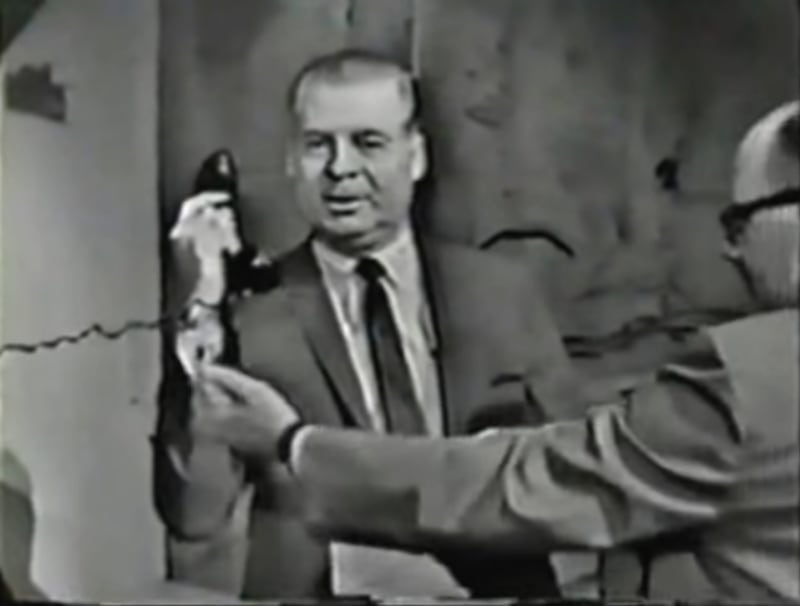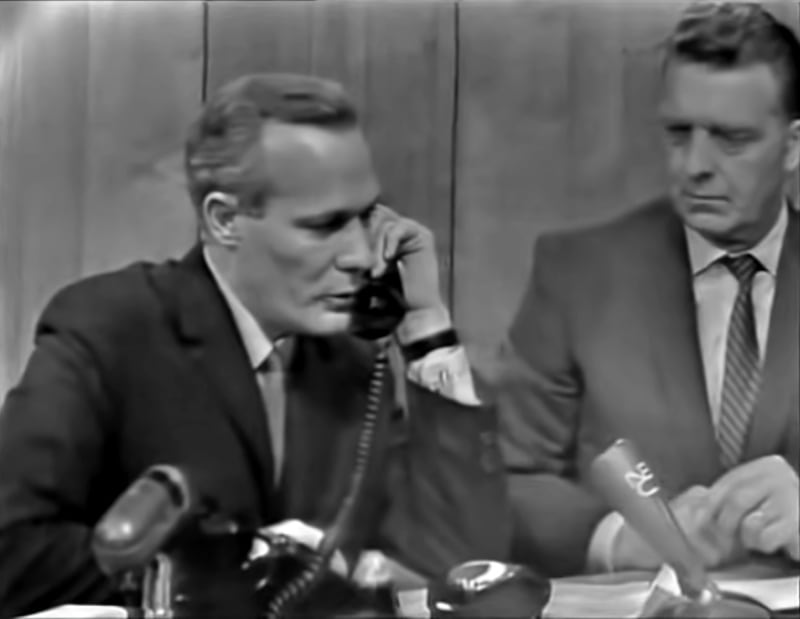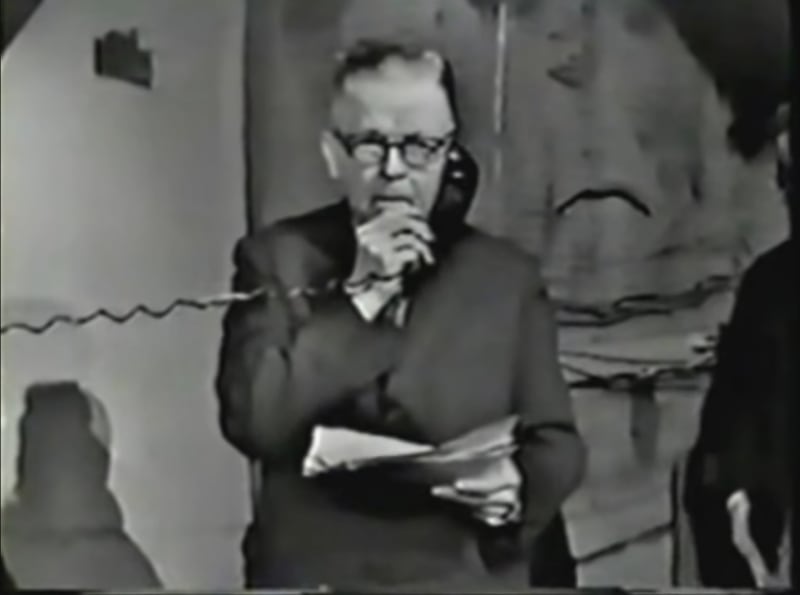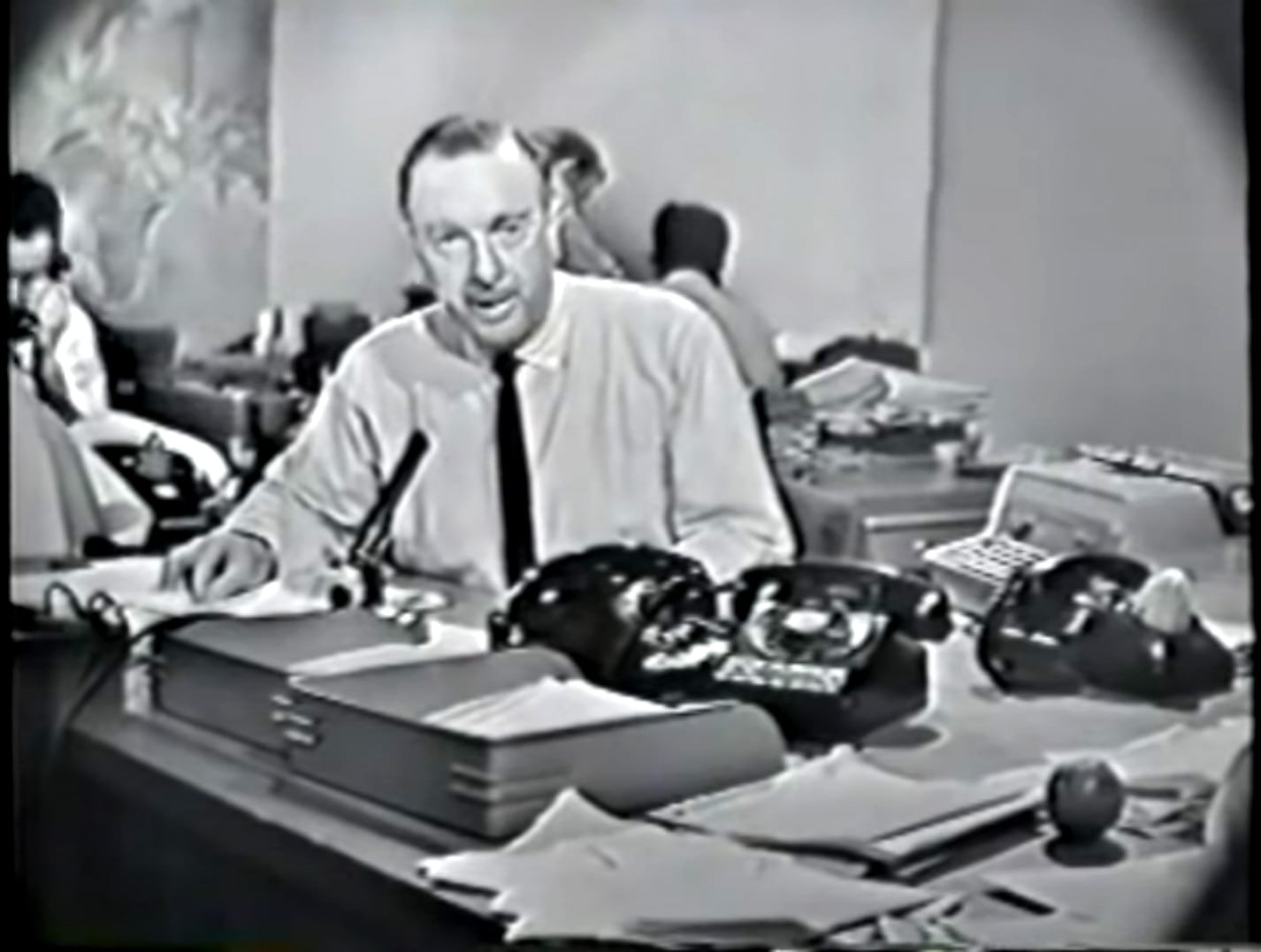
When I was a WOR Radio in the early 1980s everyone smiled when Bruce Eliot came into the newsroom to get a cup of our superior coffee. He was an amiable guy, always with a good joke.
He was the “booth announcer,” the last person to hold that job at one of the last of the great radio stations; the only other one I can think of was WQXR, owned and operated by The New York Times. He would do station identifications between shows and suchlike. He didn’t seem very old, but in a conversation with him one Saturday I learned one of his claims to fame.
WOR had years earlier been the flagship station of the Mutual Broadcasting System; even then the shadows of the letters “M U T U A L” were visible on the facade of our building at 1440 Broadway, a couple blocks south of Times Square. As a young announcer and radio actor — radio drama had been a broadcasting staple at the time he described — Bruce had drawn the shift that had him at the studios the afternoon of December 7, 1941. So it was Bruce Eliot who interrupted the Mutual and WOR broadcast of the football game between the New York Giants and the Brooklyn Dodgers (yes, such a football team existed) to inform the nation of the Japanese attack on the U.S. naval base at Pearl Harbor.
Here, sitting next to me, was a true piece of WOR’s remarkable history. I was always proud to be there, but this living, breathing connection boggled the mind.
Nothing would please me more than to go on and on about WOR 710, “The Heart of New York,” about the famous people you’d run into in the halls (the day of my job interview, I sat on the receptionist’s couch next to Sen. Sam Ervin, famous for having chaired the Senate Watergate hearings), of the legendary news people I worked alongside — Lester Smith, Harry Hennesey, Rodger Skibenes, Shelley Strickler. The sports guy was Don Criqui, whose other job was calling games for NBC and CBS television for 43 years. Our morning show, for which I was present each day, was “Rambling with Gambling,” with its second-generation host, John A. Gambling. I’d love to tell how it happened that I’d covered a garbage strike in New York City and was in the studio late one Saturday night in December 1981 when the teletypes went crazy with the news that the Soviet Union had invaded Poland, resulting in my taking air to do a 15-minute special report I’d tossed together. This interrupted the Joe Franklin show. Not all of our star personalities took kindly to such things (and we had star personalities — one you might have heard of was Arlene Francis), but when I was done and back in the newsroom assembling my garbage strike coverage, short little Joe came in, slapped me on the back, and said, “Thanks, kid, it makes the show important.” Better than an award.
I’d love to go on about all that, but that’s not what we’re talking about today.
Lately I’ve been watching the archives of the breaking news coverage of the assassination of President Kennedy. There is a lot to be learned from these, and I encourage you to watch them if you’ve never seen them before. Or to re-watch them if it’s been a while.
They raise many interesting questions, not the least being the disparity between the eyewitness accounts and the conventional explanation. It’s not wild theory to bring these up — the United States House Select Committee on Assassinations itself concluded that the president was most likely victim of a conspiracy. That, too, is something it would be fun to talk about, but again it’s not today’s subject.
Instead, I’d like to take a small look at the rather more modest but still intensely interesting way that news coverage has changed, as seen through the lens of the events of November 22, 1963, almost 60 years ago.
The CBS Television Network, the clip that most of us have seen (over and over) interrupted a fairly mild episode of “As The World Turns” (which was shot one story above in the Broadcast Center at 524 West 57th Street) with the initial bulletin, voice only over a “bulletin” card, then returned to the soap opera. It wasn’t until almost a half hour after the initial bulletin that the newsroom took the air and kept it, because it wasn’t until then that there was anything else to report. (A lack of anything to report is not an obstacle to modern newsmodels and their consultant masters.) It wasn’t until I closely re-watched the coverage recently that I discovered something of meaning to me: Walter Cronkite was sitting exactly where, a quarter century later, I would sit in my CBS news editor job. I hadn’t noticed before the enormous world map behind and to the right of Cronkite. When the room was remodeled in the mid-1980s to become the radio networks newsroom, the map was preserved in place. My desk there was where Cronkite sat as he announced the assassination.

A peculiarity of the coverage is that no one at any network or local station seemed to have taken into account the possibility that there would ever be breaking news. That was a bold assumption in the height of the cold war. The setting for Cronkite’s coverage was a noisy, confused newsroom, and that was the best of it. At NBC, the initial bulletin was read by Don Pardo, possibly the most famous booth announcer ever. In due course the network switched to Chet Huntley, Frank McGee, and Bill Ryan in a “studio” that seemed to have been a small, vacant, knotty-pine-paneled office. At ABC, things were even worse. After bulletin-card-only announcements regular programming continued, including an ad for Chooz, “the chewing gum antacid” (not to be confused with Feen-a-Mint, “the chewing-gum laxative”), the conclusion of the current episode of “Father Knows Best,” wives praising Armstrong One Step floor polish, and a promo for “The Farmer’s Daughter.” When anchor Don Goddard did finally take air, his report was the first that had an actual live report, from Bob Clark via telephone from the scene, mostly ad-libbed but excellent, full of actual news and facts. Even so, much of the coverage was via a telephone held to Goddard’s head, a phone with a curly receiver cord that had clearly been abused, as stagehands seemed to be trying to construct a set around him. Later, Ron Cochran, the evening news anchor, informed the small part of the nation watching ABC that the breaking news had interrupted his lunch. (I include screenshots — you wouldn’t believe it otherwise.)

It was a mess, with connections to Dallas and Washington failing, ending up being something else, showing unexplained scenes, and so on. ABC’s Goddard at one point had an engineer’s headset dangling from his right ear and a telephone held to his left ear. On NBC, McGee and Huntley fiddled with a gadget someone had brought in that they thought would allow them to broadcast telephonic reports, but it rendered mostly noise. David Brinkley in Washington delivered the fact that there wasn’t much news yet there in his trademark disdainful tone as if asking why they’d bothered him and made him come in, or at least why they were switching him when he had nothing to say. Remember, this was back when having something to say was a requirement for broadcast reporters. (This is no longer the case.)
The compounded technical disasters might be forgiven. It was difficult even to get a phone line out of Dallas that day (the networks were broadcasting from New York, which made no sense then and makes no sense now). For example, direct distance dialing — the ability to make a long-distance phone call without operator intervention — still wasn’t in wide use in 1963, so it was a problem getting reports from the scene at all. There were no communications satellites or portable videotape machines, so such video as there would come to be had to await processing of the 16mm film shot, usually, in Bell & Howell 70DR wind-up movie cameras. (Indeed, through the Vietnam war battle footage could not be broadcast until it had been gotten to Saigon and put on a plane for the U.S., flow there, processed, and edited. Which is why it was always broadcast two or three days after it had been shot.)
Something unimportant in the swing of things but noticeable was that anchors and other reporters smoked on the air.
It was obvious that the reporters had begun in radio — or even print; some of the reports had the flavor of being phoned in to the rewrite desk — with the niceties of television production largely ignored. It is instructive, sometimes even funny, to watch.
Yet they got it right. There were some very early reports that a Secret Service agent had been shot and killed, which turned out not to be true; there was a suggestion that Lyndon Johnson, holding his arm, had been shot, too, which also was not the case. Kennedy had been en route to make a speech at the Dallas Trade Mart, and in a confused moment Don Goddard said the president was to have made a speech at a supermarket. But they got the important stuff right and given the chaos of the scene both in Dallas and in New York it’s amazing that they didn’t get much wrong.

What was most surprising to me was, as I said, that none of the networks had any system in place for the coverage of important breaking news. None. It really was as if the thought had never occurred to them. ABC’s was by far the worst — at times it seemed as if it were coming to you live from the janitors closet.
What might be surprising to you is that the technical side of things didn’t get any better for decades. When I was a radio reporter in the 1980s one of my jobs was to know where the nearest telephone was. Covering stories, I’d often have to knock on doors not to get information but to ask to use the phone. I carried a “Voice Act,” a gadget that I could screw into a phone in place of its microphone which allowed me to play tape down the line, but that was as elaborate as it got. I wrote an article in 1981 for the radio newsroom publication “Earshot” in which I predicted that this cellular telephone thing being talked about might over time prove useful to radio reporters.
What wasn’t a surprise at all was how the reporters were all actual reporters. They had been hired due to their ability to collect and disseminate factual information in a hurry. I don’t think any of them had studied “journalism,” which meant there was a good chance that they also possessed broad general knowledge. You can watch coverage from that era and at the end have the facts of the story without the slightest idea of the reporter’s personal opinion of it.

That stands in sharp contrast to today, when the technology allows broadcasters to report just about anything that happens just about anywhere almost instantly. Rather than build on the competence of that earlier generation and use the new technology to make news reports even better, they’ve gone flabby. In the early 1980s the consultants came up with an idea called “relatability,” which in practical terms meant broadcast reporters were to be as clueless as their audience. At this they have overwhelmingly succeeded. There was no difficulty finding such reporters. News directors and news consultants concentrate on reporters’ appearance rather than their competence (though there are still some competent reporters, probably by accident). But news personalities — we can’t call them reporters — have largely turned to gossiping about the news. Monday morning a young man, Bryan Kohberger, was arraigned in Idaho on charges that he had stabbed to death four other young people. He did not enter a plea, so the judge entered a “not guilty” plea in his behalf. Those two sentences are 100 percent of the news that took place. Which did not prevent the “news” anchors rattling on about it for most of 20 minutes with nothing to add because there wasn’t anything to add. But their hair was perfect and the studio looked like a disco.

Dennis E. Powell is crackpot-at-large at Open for Business. Powell was a reporter in New York and elsewhere before moving to Ohio, where he has (mostly) recovered. You can reach him at dep@drippingwithirony.com.
You need to be logged in if you wish to comment on this article. Sign in or sign up here.
Start the Conversation